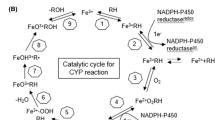Summary
Cytochrome P450 1A2 (CYP1A2) accounts for about 10 to 15% of the total CYP content of human liver and is the major enzyme involved in the metabolism of imipramine, propranolol, clozapine, theophylline, and caffeine. It is also involved in the conversion of heterocyclic amines to their proximal carcinogenic and mutagenic forms, as well as in the metabolism of endogenous substances, including 17β-estradiol and uroporphyrinogen III. Fluvoxamine is a potent inhibitor of CYP1A2, and there is potential for interaction with drugs that are metabolised by this isoenzyme. This property of fluvoxamine may be usefully applied to identifying agents that are substrates of CYP1A2, and it has a possible therapeutic application in the prevention of CYP1A2-mediated toxic metabolite formation.
Similar content being viewed by others
References
Sesardic D, Boobis AR, Edwards RJ, et al. A form of cytochrome P450 in man, orthologous to form d in the rat catalyses the O-deethylation of phenacetin and is inducible by cigarette smoking. Br J Clin Pharmacol 1988; 26: 363–72
Eugster HP, Probst M, Wurgler FE, et al. Caffeine, estradiol, and progesterone interact with human CYP1A1 and CYP1A2. Evidence from cDNA-directed expression in Saccharomyces cerevisiae. Drug Metab Disp 1993; 21: 43–9
Lambrecht RW, Sinclair PR, Gorman N. et al. Uroporphyrinogen oxidation catalysed by reconstituted cytochrome P4501A2. Arch Biochem Biophys 1992; 294: 504–10
Spink DC, Eugster HP, Lincoln DW, et al. 17β-estradiol hydroxylation catalyzed by human cytochrome P450 1A1: a comparison of the activities induced by 2,3,7,8-tetrachlorodibenzo-p-dioxin in MCF-7 cells with those from heterologous expression of the cDNA. Arch Biochem Biophys 1992; 293: 342–8
Brøsen K, Gram LF, Kragh-Sørensen P. Extremely slow metabolism of amitriptyline but normal metabolism of imipramine and desipramine in an extensive metabolizer of sparteine, debrisoquine, and mephenytoin. Ther Drug Monit 1991; 134: 177–82
Skjelbo E, Brøsen K. Inhibitors of imipramine metabolism by human liver microsomes. Br J Clin Pharmacol 1992; 34: 256–61
Spina E, Campo GM, Avenoso A, et al. Interaction between fluvoxamine and imipramine/desipramine in four patients. Ther Drug Monit 1992; 14: 194–6
Diot P, Jonville AP, Gerard F, et al. Possible interaction entre theophylline et fluvoxamine. Therapie 1991; 46: 170–1
Sperber AD. Toxic interaction between fluvoxamine and sustained release theophylline in an 11-year-old boy. Drug Saf 1991; 6: 460–2
Thomson AH, McGovern EM, Bennie P, et al. Interaction between fluvoxamine and theophylline. Pharm J 1992; 249: 137
Grygiel JJ, Birkett DJ. Cigarette smoking and theophylline clearance and metabolism. Clin Pharmacol Ther 1981; 30: 491–6
Sarkar MA, Hunt C, Guzelian PS, et al. Characterisation of human liver cytochromes P450 involved in theophylline metabolism. Drug Metab Dispos 1992; 20: 31–7
Brøsen K. The pharmacogenetics of the selective serotonin reuptake inhibitors. Clin Invest 1993; 71: 1002–9
Brøsen K, Skjelbo E, Rasmussen BB, et al. Fluvoxamine is a potent inhibitor of cytochrome P4501A2. Biochem Pharmacol 1993; 45: 1211–4
Rasmussen BB, Mäenpää J, Pelkonen O, et al. Selective serotonin reuptake inhibitors and theophylline metabolism in human liver microsomes: potent inhibition by fluvoxamine. Br J Clin Pharmacol 1995; 39: 151–9
Guengerich FP, Kim D-H, Iwasaki M. Role of human cytochrome-P450 IIEI in the oxidation of many low molecular weight cancer suspects. Chem Res Toxicol 1991; 4: 168–79
Jerling M, Lindström L, Bondeson V, et al. Fluvoxamine inhibition and carbamazepine induction of the metabolism of clozapine: evidence from a therapeutic drug monitoring service. Ther Drug Monit 1994; 16: 368–74
Bertilsson L, Carrillo JA, Dahl M-L, et al. Clozapine disposition covaries with CYP1A2 activity determined by a caffeine test. Br J Clin Pharmacol 1994; 38: 471–3
Boobis AR, Lynch AM, Murray S, et al. CYP1A2 catalyzed conversion of dietary heterocyclic amines to their proximate carcinogen is their major route of metabolism in humans. Cancer Res 1994; 54: 89–94
Raucy JL, Lasker JM, Lieber CS, et al. Acetaminophen activation by human liver cytochromes P450IIE1 and P4501A2. Arch Biochem Biophys 1989; 271: 270–83
Author information
Authors and Affiliations
Rights and permissions
About this article
Cite this article
Brøsen, K. Drug Interactions and the Cytochrome P450 System. Clin. Pharmacokinet. 29 (Suppl 1), 20–25 (1995). https://doi.org/10.2165/00003088-199500291-00005
Published:
Issue Date:
DOI: https://doi.org/10.2165/00003088-199500291-00005




